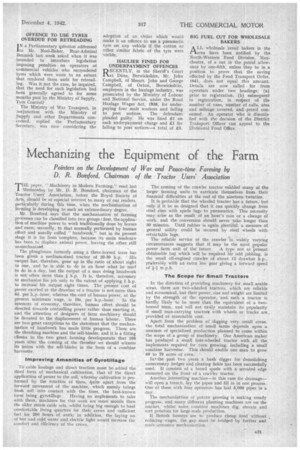Mechanizing the Equipment of the Farm
Page 23

If you've noticed an error in this article please click here to report it so we can fix it.
Pointers on the Development of War and Peace-time Farming by D. R. Bomford, Chairman of the TraCtor Users' Association
THE paper, "Machinery in Modern Farming," read last Wednesday by Mr. D. R. Bornford, chairman of the Tractor Users' Association, before the Royal Society of Arts, should be of especial interest to many of our readers, particularly during this time, when the mechanization of farming is developing to such an extraordinary degree.
Mr. Bomford says that the mechanization of farming processes can be classified into two groups:first, the application of machine power to work traditionally done by horses and oxen; secondly, to that normally performed by human effort and usually called "handwork," but in its present stage it is far from complete, because its main tendency has been to displace animal power, leaving the other still unmechanized.
The ploughman formerly using a three-horsed team has been given a medium-sized tractor of 20-30 h.p. His output has, therefore, gone up in the ratio of about eight to one, and he is able to do in an hour what he used to do in a day, but the output of a man doing handwork is not often more than h.p. It is, therefore, necessary to mechanize his job only to the extent of applying_l h.p. to increase his output eight times. The present cost of power exerted at the drawbar of a tractor is not-more than 6d. per h.p.-hour, whereas the cost of human power, at the present minimum wage, is 10s. per h.p.-hour. In the interests of economy, therefore, human effort should be directed towards controlling power rather than exerting it, and the attention of designers of farm machinery should be devoted to the displacement of human labour. There are two great exceptions to the statement that the mechanization of handwork has made little progress. These are the threshing machine and the self-binder, and it is a fitting climax to the two great farming developments that 100 years after the coming of the thresher -we should witness its nnion with the self-binder in the form of a combin.e harvester.
Improving Amenities of Gyrotiliage
To cable haulage and direct traction must be added the third form of mechanical cultivation, that of the direct application of power to the soil, whereby cultivation is performed by the rotation of tines, quite apart from the' forward movement of the machine, which merely brings fresh soil into contact with the tines, the best-known form being gyrotillagc. Having no implements to take with them, machines for this work are more mobile than Ihe older steam cable sets, whilst being big enough to haul comfortable living quarters for their, crews and sufficient fuel for 200 hours of work; in addition, the laying on of hot and cold water and electric light would increase the comfort and efficiency of the crews.
The coming of the crawler tractor enhbled many of the larger farming units to extricate themselves from their financial difficulties at the end of the nineteen twenties. .
It is probable that the wheeled tractor has a future,. but only if it be so designed that it can quickly change from steel rims with spade lugs to pneumatics. This necessity may arise as the result of an hour's rain or, a change of work, and the conversion should never take longer than 30 minutes. Until rubber is again plentiful, a measure of general utility could be secured by steel wheels with retractable lugs.
The reliable service of the crawler in widely varying
circumstances suggests that it may be the most popular power -farm unit of the future. A type not at present obtainable bu,t which will be required for odd jobbing, is the small oil-engined crawler of about 12 drawbar h.p., preferably with an extra low gear giving a forward speed of H m .p.h .
The Scope for Small Tractors In the direction of providing machinery for small arable areas, there are two-wheeled tractors, which are reliable and economical, but their power, size and weight are limited by the strength of the operator, 'and, such a tractor is hardly likely to be more than the equivalent of a two. horsed team, and will not easily maintain its popularity if small man-carrying tractors with wheels or tracks are provided at reasonable cost.
Apart from the problem of digging very, small areas. the total mechanization of small farms depends upon a measure of specialized production planned to come within the scope of a group of machinery. One American maker has produced a -small four-wheeled tractor with all the, ' implements required for corn growing, including a small combine harvester. This should enable one man to grow 60 to 70 acres of corn.
In•the . past two years a bush digger for demolishing unnecessary hedges and clearing fields has been successfully used. It consists of a broad spade with a serrated edge mounted on the front of a crawler tractor.
Another interesting machine—in this case for drainage-Will open a trench, lay the pipes and fill in in one process. One of these with four operators has laid 5,000 pipes in a day.
The mechanizetion of potato growing is making steady progress, and many different planting machines are on the market, whilst some combine machines dig, elevate and sort potatoes for large-scale production, If British farmers are to produce cheap food without , reducing wages, the gap must be bridged by fu-rther and move intensive mechaaizatiou.




















































